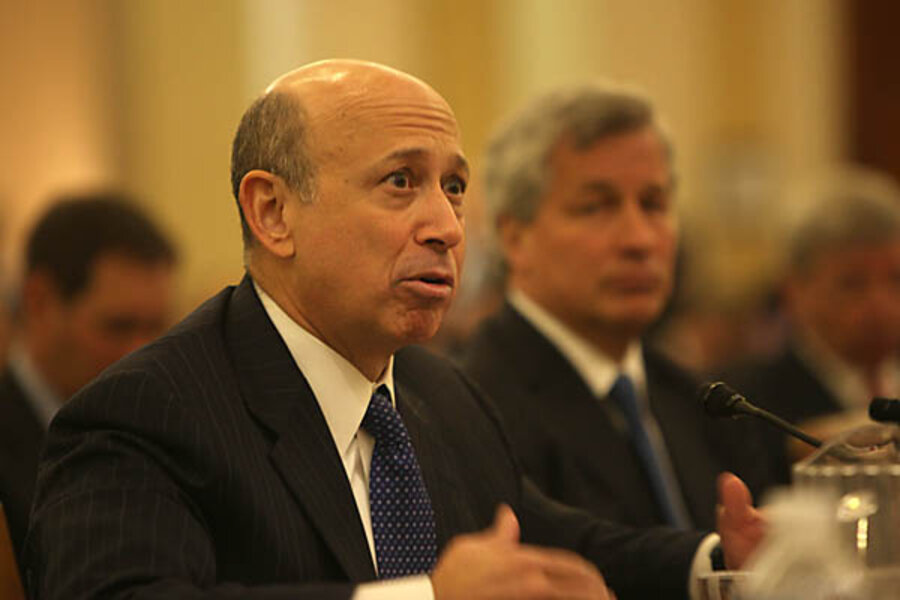Break up the banks: Why we must limit the size of banks
A fight is brewing in Washington – or, at the least, it ought to be brewing – over whether to put limits on the size of financial entities in order that none becomes “too big to fail” in a future financial crisis.
Some background: The big banks that got federal bailouts, as well as their supporters in the Administration and on the Hill, repeatedly say much of the cost of the giant taxpayer-funded bailout has already been repaid to the federal government by the banks that were bailed out. Hence, the actual cost of the bailout, they argue, is a small fraction of the $700 billion Congress appropriated.
True, but the apologists for the bailout leave out one gargantuan cost — the damage to the economy, which we’re still living with (witness the latest unemployment figures). Leave it to the Brits to calculate this. Andrew Haldane, Bank of England’s Financial Stability Director, figures the financial crisis brought on by irresponsible bankers and regulators has cost the world economy about $4 trillion so far.
So while the bailout itself is gradually being repaid (don’t hold your breath until AIG and GM repay, by the way), the cost of the failures that made the bailout necessary totals vast multiples of that.
Needless to say, the danger of an even bigger cost in coming years continues to grow because we still don’t have a new law to prevent what happened from happening again. In fact, now that they know for sure they’ll be bailed out, Wall Street banks – and those who lend to them or invest in them – have every incentive to take even bigger risks. In effect, taxpayers are implicitly subsidizing them to do so. (Haldane figures the value of that implicit subsidy to be about $60 billion a year for each big bank.)
Congress and the White House tell us not to worry because financial reform legislation will contain what’s called a “resolution” mechanism allowing regulators to wind down any big bank that gets into trouble. (Think bankruptcy with more safeguards against runs by bank by creditors wanting to get their money out right away.) By virtue of this resolution authority, they say, future bank creditors will have to price in the possibility of the bank being allowed to fail. Hence, the implicit subsidy for risk-taking will disappear. At least that’s the theory.
But the theory isn’t likely to work in practice. Do you really believe bank regulators will use the resolution authority — especially if two or more giant banks are endangered at the same time? Multiple threats are almost certain because each big bank races to copy any gambling technique that pays off big for any other. The reality is, they’ll get bailed out.
Even if the resolution authority were combined with an array of new regulations designed to cover all the “shadow banking” operations of the giant banks — requiring that they put up more capital and thereby limit their leverage – there’s no way such regulations can succeed. The giant banks already hire fleets of lawyers, accountants, and financial entrepreneurs to find loopholes in every existing regulation.
Finally, consider the political power of the big Wall Street banks. They and their executives and employees are now among the biggest contributors to both parties. Wall Street lobbyists are crawling over Capitol Hill. The banks and their lobbyists will ensure that regulatory loopholes are built into regulations from the start. Remember: They dismembered Glass-Steagall (with the help of their friends in the Fed, on the Hill, and in the Clinton White House), and fought off derivative regulation (ditto).
As long as the big banks are allowed to remain big, their political leverage over Washington will remain big. And as long as their political leverage remains big, the taxpayer and economic tab for the next mess they create will be big.
By all means, give regulators resolution authority and also impose the tightest regulations possible. But Congress and the White House shouldn’t stop there. Limits should be placed on how big big banks can become.
How big? No one has been able to show significiant efficiencies over $100 billion in assets. Make that the outside limit.
To be sure, smaller banks might still be subject to runs. That’s why the Federal Deposit Insurance Corporation was created in the 1930s – to ensure depositors in the event a bank gets into trouble, so they won’t have to run to protect their savings. And why the Glass-Steagall Act was passed – to separate commercial banking (where depositors put their money) from investment banking (where betting is done). We could expand insurance to certain categories of bank creditor, and we should resurrect Glass-Stagall.
But the only way to make sure no bank it too big to fail is to make sure no bank is too big. If Congress and the White House fail to do this, you have every reason to believe it’s because Wall Street has paid them not to.
Add/view comments on this post.
------------------------------
The Christian Science Monitor has assembled a diverse group of the best economy-related bloggers out there. Our guest bloggers are not employed or directed by the Monitor and the views expressed are the bloggers' own, as is responsibility for the content of their blogs. To contact us about a blogger, click here. To add or view a comment on a guest blog, please go to the blogger's own site by clicking on the link above.





